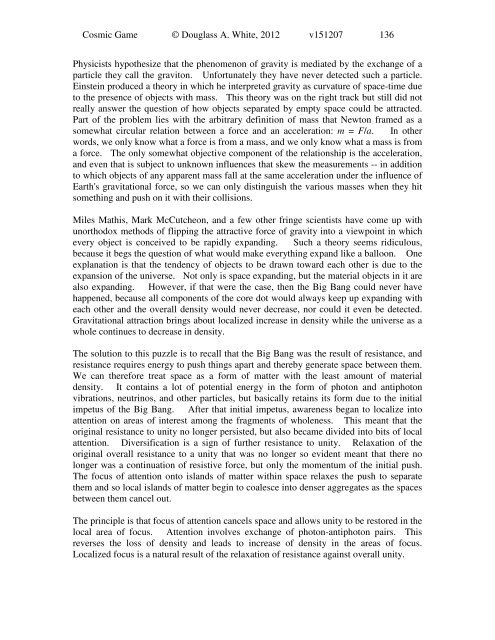You also want an ePaper? Increase the reach of your titles
YUMPU automatically turns print PDFs into web optimized ePapers that Google loves.
<strong>Cosmic</strong> <strong>Game</strong> © Douglass A. White, 2012 v151207 136<br />
Physicists hypothesize that the phenomenon of gravity is mediated by the exchange of a<br />
particle they call the graviton. Unfortunately they have never detected such a particle.<br />
Einstein produced a theory in which he interpreted gravity as curvature of space-time due<br />
to the presence of objects with mass. This theory was on the right track but still did not<br />
really answer the question of how objects separated by empty space could be attracted.<br />
Part of the problem lies with the arbitrary definition of mass that Newton framed as a<br />
somewhat circular relation between a force and an acceleration: m = F/a. In other<br />
words, we only know what a force is from a mass, and we only know what a mass is from<br />
a force. <strong>The</strong> only somewhat objective <strong>com</strong>ponent of the relationship is the acceleration,<br />
and even that is subject to unknown influences that skew the measurements -- in addition<br />
to which objects of any apparent mass fall at the same acceleration under the influence of<br />
Earth's gravitational force, so we can only distinguish the various masses when they hit<br />
something and push on it with their collisions.<br />
Miles Mathis, Mark McCutcheon, and a few other fringe scientists have <strong>com</strong>e up with<br />
unorthodox methods of flipping the attractive force of gravity into a viewpoint in which<br />
every object is conceived to be rapidly expanding. Such a theory seems ridiculous,<br />
because it begs the question of what would make everything expand like a balloon. One<br />
explanation is that the tendency of objects to be drawn toward each other is due to the<br />
expansion of the universe. Not only is space expanding, but the material objects in it are<br />
also expanding. However, if that were the case, then the Big Bang could never have<br />
happened, because all <strong>com</strong>ponents of the core dot would always keep up expanding with<br />
each other and the overall density would never decrease, nor could it even be detected.<br />
Gravitational attraction brings about localized increase in density while the universe as a<br />
whole continues to decrease in density.<br />
<strong>The</strong> solution to this puzzle is to recall that the Big Bang was the result of resistance, and<br />
resistance requires energy to push things apart and thereby generate space between them.<br />
We can therefore treat space as a form of matter with the least amount of material<br />
density. It contains a lot of potential energy in the form of photon and antiphoton<br />
vibrations, neutrinos, and other particles, but basically retains its form due to the initial<br />
impetus of the Big Bang. After that initial impetus, awareness began to localize into<br />
attention on areas of interest among the fragments of wholeness. This meant that the<br />
original resistance to unity no longer persisted, but also became divided into bits of local<br />
attention. Diversification is a sign of further resistance to unity. Relaxation of the<br />
original overall resistance to a unity that was no longer so evident meant that there no<br />
longer was a continuation of resistive force, but only the momentum of the initial push.<br />
<strong>The</strong> focus of attention onto islands of matter within space relaxes the push to separate<br />
them and so local islands of matter begin to coalesce into denser aggregates as the spaces<br />
between them cancel out.<br />
<strong>The</strong> principle is that focus of attention cancels space and allows unity to be restored in the<br />
local area of focus. Attention involves exchange of photon-antiphoton pairs. This<br />
reverses the loss of density and leads to increase of density in the areas of focus.<br />
Localized focus is a natural result of the relaxation of resistance against overall unity.





